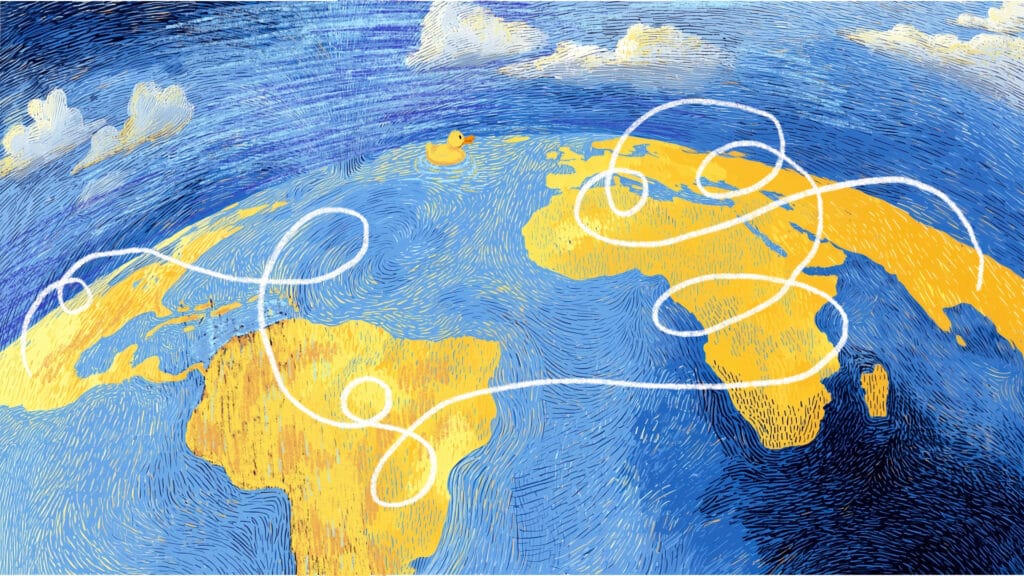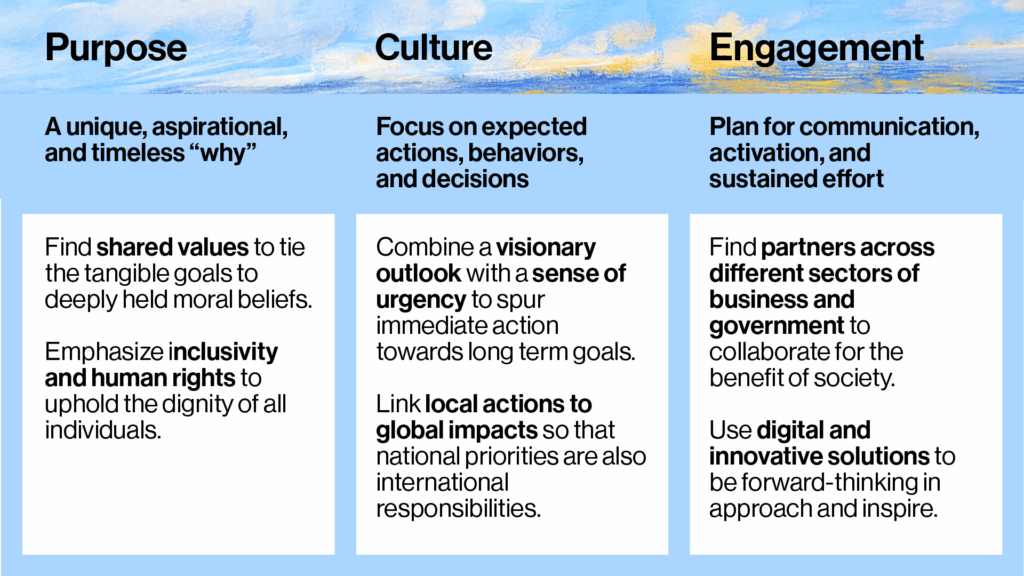Introduction
How do we do hard things? Some would say reward people with incentives. Others might stress forming the right partnerships. Still others might argue for a foolproof plan. And though all of these are great answers that are not mutually exclusive, we believe the most crucial step to achieving goals is often the most overlooked: finding a compelling reason why. As author and aviator Antoine de Saint-Exupery wrote, “If you want to build a ship, don’t drum up the men to gather wood, divide the work, and give orders. Instead, teach them to yearn for the vast and endless sea.”
Finding a compelling why and articulating it in a memorable and motivating way often takes the form of strategic narratives. They are a vital tool to guiding people in the pursuit of larger goals. When properly excavated and expertly activated, they can create movements and mobilize millions to achieve the most ambitious goals. And to better serve humanity this century, we will need more of them.
The UN SDGs
In 2015, the UN General Assembly launched Sustainable Development Goals (SDGs) across myriad societal dimensions, aiming to address the world’s most pressing issues including poverty, inequality, climate change, peace, and more. Ambitious goals were set with the intention of meeting them all before 2030. Yet at the halfway mark in 2023, a summit was held to draw attention to a lack of progress in key areas. Secretary-General Antonio Guterres said, “Unless we act now, the 2030 agenda will become an epitaph for a world that might’ve been.”1
But the news wasn’t all grim. Though many countries hadn’t failed to make the necessary progress, others demonstrated notable success. And surprisingly, it wasn’t always the wealthier countries with the most resources leading the way. To the contrary, several low- or middle-income countries made tremendous progress very quickly. To name a few, Rwanda has become a global leader in advancing gender equality, Indonesia has advanced access to affordable and clean energy, and Bhutan’s “National Digital Strategy” has accelerated its progress in advancing education and literacy.2
So, if wealth isn’t the primary driver for progress, what is? Research has shown compelling storytelling can engage and mobilize the public to act earlier and move faster in making progress towards public policy goals.3 And once progress is seen, it engenders trust in institutions, attracts further support, and accelerates overall momentum. A well-crafted strategic narrative can be the catalyst for such progress, transforming a nation far beyond utilizing economic means alone.
The Power of Narrative

It’s natural to wonder how and why the presence of a strong narrative can have such an outsized influence. To explain, it’s important to remember that we’re not talking about mere storytelling. The process is far more rigorous. It involves a structured approach of listening and then conveying messages that resonate deeply with target audiences to foster engagement, unity, and a shared sense of purpose.
Not only do these stories resonate and engage, but they also explain complex issues in memorable ways, invite people to imagine other possibilities, and shape an understanding of the role individuals play in making global progress.
You don’t get policy change without narrative change first… I think there’s no way to build a movement without a galvanizing idea and story at the heart of it.
Dr. Katherine Wilkinson
Co-Founder, The All We Can Save Project
This type of storytelling is precisely what is needed to action on the UN’s SDGs. Many people still remain unaware of the SDGs or their importance, resulting in insufficient support for necessary policies and initiatives. We can’t let the lack of awareness and engagement stop us. A better, healthier, more just and prosperous world is waiting for us at the other end of these finely crafted narratives.
Consider how narratives in the following countries have led to remarkable progress:
Case Studies

.
Bhutan:
An Imagination for the Next Century
.
Bhutan has made astonishing progress toward SDG 4 (Education) with a 70 point increase in realizing its target commitments.4 Led by a comprehensive vision of “Gross National Happiness,” Bhutan has closed the gap on everything from adult and child literacy, to primary school access, to teacher training and recruitment. It has done so through a compelling narrative vision, emphasizing not just pride in Bhutanese culture but the possibilities unique cultural strengths can bring about.
As his Majesty King Jigme Khesar wrote, “We cannot compare present progress with our past and celebrate it as a measure of success… [W]e must aspire to…become the standard-bearers. Such an aspiration is not an expression of misplaced idealism. Rather, it is founded on the strength of conviction that our survival as a sovereign state will depend on the physical, emotional, psychological, intellectual, and moral make of our children.”5
A narrative rooted in shared strengths and values can unite even diverse sectors like agriculture, telecommunications, and education around a common goal. This unity fosters novel solutions through inspired collaboration. Bhutan’s latest Five-Year Plan includes a National Digital Strategy that has rapidly brought 87% of its population online, increased access to remote learning, and, through advanced digital planning, reduced school meal costs by 15% while promoting more diverse, nutrient-dense meal options for students.6
.
Portugal:
A Focused, Urgent Call to Action
.
By contrast, Portugal’s narrative on SDG 1 (Poverty) is introspective and urgent rather than expansive and imaginative, focusing on existing inequalities and the moral imperative to act. The tone of the narrative meets the seriousness of the moment with blunt honesty, transparent data, and detailed strategy. Portugal’s narrative approach is comprehensive in nature, conveying the breadth and importance of poverty reduction.
The Portuguese government frames the narrative this way, “Despite [positive] developments, around 2 317 236 people remain at risk of poverty or social exclusion, and 389 686 of these are children. This circumstance led the Government to assume the need to create a national public policy instrument with a set of coherent, coordinated and integrated actions aimed to significantly reduce poverty incidence.”7
By acknowledging societal challenges and emphasizing ethical responsibility, Portugal created a compelling call for collective action and solidarity, and the results speak for themselves. Since implementing their national strategy, Portugal’s overall poverty has fallen below the EU average, with nearly 660,000 fewer Portuguese citizens experiencing poverty compared to 10 years ago. When comparing Portugal to Bhutan, we see that blanket narrative approaches are not the recommendation. Rather, narratives must reflect the distinct and authentic strengths, concerns, and cultural identities of the stakeholders involved.
.
Greece and Croatia:
Inclusive and Collaborative Efforts
.
A similar example can be seen in how nearby countries Greece and Croatia framed narratives to address SDG 10 (Reduced Inequality). Greece emphasized social justice and accessibility, reflecting on how past challenges could fuel ongoing efforts, while Croatia focused on collaborative efforts and citizen involvement, committing to partnerships to establish future work.
For Greece, narrative language of “social inclusion” is paramount and provides the framework for any initiative aimed at reducing social inequality. Consider how Greece frames access to public transportation as “critical to societal participation, helping to offer access to education, healthcare, employment, and everyday routines [and we must] ensure that everyone has access to the transportation they require or desire.”8
Whereas Croatia’s focus on partnerships and collaboration is most clear in its promotion of civil society organizations and their role in promoting social and economic equality. Croatia’s messaging places Civil Society Organizations at the center because, “CSOs promote sustainable development at the local, national and international levels by organising educational programmes and holding public campaigns, by focusing on the effects of business on society and the environment, by advocating putting effort into and investing in environmental protection and social issues, thereby taking responsibility for the effects of doing business.”9
Both Greece and Croatia’s narrative approaches are progressive in tone, focusing on social advancement and collective responsibility. Though they differ slightly in emphasis, they demonstrate how inclusive storytelling can mobilize diverse stakeholders and drive meaningful progress.
Dimensions of a Successful Narrative
This is just a small sampling of how powerful, emotionally driven stories shaped real world progress. Sure, efforts can be made that will yield some results by just focusing on the tasks. But a true appreciation of what’s at stake, taking in a holistic picture, and crafting the right strategic narrative is far more impactful.
Successful narratives like these often bear the hallmarks of influential social movements:

As narratives succeed across these three movement dimensions: defining a purpose, activating that purpose through a distinct culture, and inspiring and engaging stakeholders, the narrative impact becomes exponential.
Humans can cooperate with countless numbers of strangers because we can create and believe in stories. Unlike other animals, we use our language not merely to describe reality, but also to create new realities. And when we all believe in the same story of a new reality, we can cooperate.
Dr. Yuval Harari
Historian, philosopher, and best-selling author of Sapiens, Homo Dues, and 21 Lessons for the 21st Century
From recent successes to our long history crafting effective narratives, BCG BrightHouse knows the metrics that must be present to maximize impact in a strategic narrative. It’s important to ensure stories are reflective of the aspirations of the communities they serve. It’s helpful to appeal to the interconnected nature of our complex global community and to find a need in the world that must be answered. And lastly, employing various strategies and creative expressions must not be overlooked. That’s how we reach the right audiences, in the right ways, at the right time.
We don’t just want this; we yearn for it. We desperately strive to create this world that might be, because it’s not just work for us, it’s a better future for our children. It means creating a global community that cooperates to ensure every person has a richer life and humanity itself becomes a richer species. in order to do this, we have to start telling better stories. Stories of the bright possibilities we will always reach for, long after the temporary facts of our shortcomings are forgotten.

Design:
Anna LeBer, Designer, BCG BrightHouse
1 “Press Release | UN Chief Calls for Fundamental Shift to Put World Back on Track to Achieving the Sustainable Development Goals,” United Nations (April 26, 2023), https://www.un.org/sustainabledevelopment/blog/2023/04/press-release-un-chief-calls-for-fundamental-shift-to-put-world-back-on-track-to-achieving-the-sustainable-development-goals/
2 “Digital Transformation: Bhutan’s Key to SDG Acceleration” United Nations Development Coordination Office (June 12, 2024), https://un-dco.org/stories/digital-transformation-bhutans-key-sdg-acceleration
3 Marshall Ganz, “Public Narrative, Collective Action, and Power,” Accountability Through Public Opinion: From Inertia to Public Action (2011, pp. 273-289).
4 Vincent Chin, Rich Hutchinson, Bill Morneau, and Ellen Halle, “The Sustainable Development Goals Matter More Than Ever,” BCG (October 15, 2023), https://www.bcg.com/publications/2023/how-governments-can-deliver-on-sdg-initiatives
5 “Royal Kashos on Education Reform and Civil Service Reform,” Bhutanese Broadcasting Service (February 2, 2021), https://www.bbs.bt/143221/
6 “Digital Transformation: Bhutan’s Key to SDG Acceleration,” United Nations Development Coordination Office (June 12, 2024), https://un-dco.org/stories/digital-transformation-bhutans-key-sdg-acceleration
7 Portuguese National Action Plan 2022-2030: National Coordination Child Guarantee (January 2023)
8 “Main Challenges to Social Inclusion,” EU National Policies Platform (November 28, 2023)
9 Government of the Republic of Croatia, “Voluntary National Review of the UN 2030 Agenda for Sustainable Development Implementation,” United Nations (June 30, 2019), https://national-policies.eacea.ec.europa.eu/youthwiki/chapters/greece/41-general-contexthttps://sustainabledevelopment.un.org/content/documents/23943CROATIA_UN_final.pdf